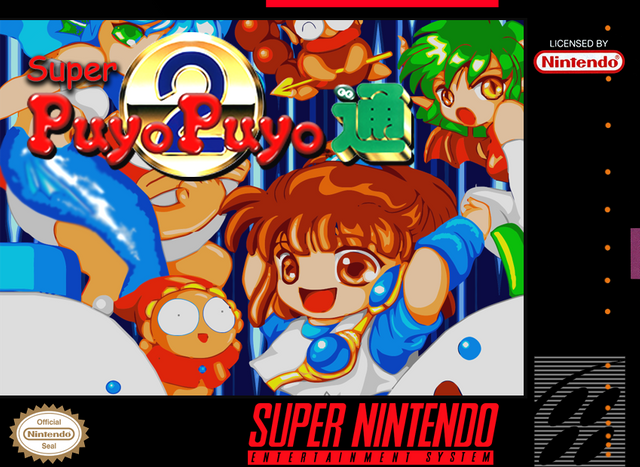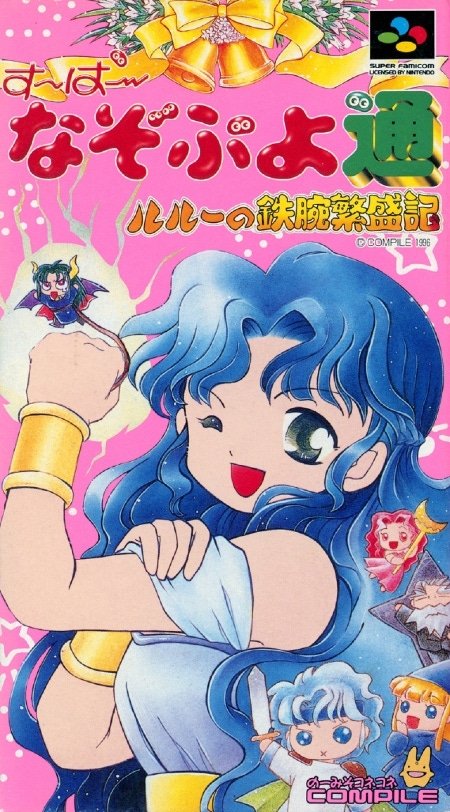My Played Video Games Review: Super Puyo Puyo 2 for the Super Nintendo

Super Puyo Puyo 2 is a puzzle game released in 1994 by Compile (Japanese video game developer which went bankrupt in 2003) and released on various platforms. It is the second game in the Puyo Puyo series and follows up on the original Puyo Puyo on the NES/Famicom from 1992. This SNES version came out in 1995.
I would go so far as to say that the Puyo Puyo games are second only to Tetris in terms of their retro gaming significance. While earlier puzzle games dabbled in competitive modes where you just tried to outlast or outscore your opponent, Puyo Puyo games truly made it feel like a head-to-head battle. What you did on your side of the screen could directly mess with your opponent’s game. And that changed everything. This idea became so damn good that many puzzle games that followed shamelessly copied the concept.

The Story
The goal in this fast-paced, head-to-head puzzle game is to clear your screen of falling blobs called Puyos by matching four or more of the same color in lines or matching patterns. The real challenge and fun comes in multiplayer: when you clear a chain of Puyos, it sends junk pieces over to your opponent’s screen. The bigger your combo, the more junk you drop on them. If their screen fills to the top, you win the round. It is simple to pick up, but mastering the combos and timing takes admirable skill.
(Ja)(SwitchOnline)(1).png.72b9db87c1a7be246595f5f35affcd88.png)
The Graphics and Sound
The visuals are bright, colorful, and have a charming style. While this SNES version looks a bit simpler, almost like it was made with Microsoft Paint, it is still well-crafted and full of personality. The Sega Genesis version has a darker tone and more detailed shading, which gives it a slightly polished look overall.
The music is upbeat and catchy without being repetitive, making it a nice fit for the fast-paced gameplay. The sound effects, however, are not quite as strong. Interestingly, the Seg Genesis version uses different voice actors, and the performances there are more expressive and emotional. On the SNES, the voices can come off as flat and a bit cheesy.
The Gameplay
Two or more players play the game at the same time using the split-screen. Everyone gets the same pieces in the same order. The goal is simple: be the last one standing. But here’s the twist—if you make combos or chains, you send junk blobs over to your opponent’s screen. To get rid of these, they have to make combos next to them. Bigger combos send more junk, and chains (which are harder to pull off) send full rows—plus extra rows for each link in the chain.
This can be fun and adds a lot of excitement and pressure, pushing players to make smart, fast moves. But it also turns the game into more of a speed and luck contest, rather than a strategy game. It can get super frustrating when your opponent keeps dropping on you, and you can’t do anything but sit there and cry.
That might be fine if you’re playing against a friend. But against the computer? It’s brutal. Puyo Puyo is known for its tough AI. Even on easy mode, it’s not a shame to get completely wiped out in under 30 seconds by a level 3 opponent.
Somehow, the developers tweaked the gameplay just enough to make it feel smoother and way less frustrating, while still keeping the difficulty high. The biggest change? You can now cancel incoming junk by making your own combos or chains before it lands. This makes the game way more balanced and lets you play more strategically. It is a small change, but it makes a good difference.
If you want to play solo, there's an easy mode with just three opponents to help you practice. It’s a great way to warm up for the main arcade/story mode. That mode has been reworked too—now you progress through tiers by earning points, and you don’t have to beat every opponent to move on. It is more flexible and gives you a way around characters you struggle with.
The game is still tough, no doubt. The difficulty ramps up so fast it feels impossible at first—but it actually levels out. Once you get past the initial grind, you can start to make real progress. It still won’t be easy, but it’s definitely doable with practice.
There’s also a 2-player mode, and even up to 4-player support. It makes the game's replay value great as always.
Even Endless Mode got some love. You can now pick new variations like Action or Wild, where random garbage drops from above and power-ups show up. These changes make the mode way more fun and useful for practice.
My Verdict
Super Puyo Puyo 2 fixes a lot of the problems from the previous game and adds a bunch of small features that really improve the experience. It’s still hard, still intense. But now it is fair, strategic, and way more fun to play
Play it on the beloved Super Nintendo/Super Famicom or play it on a trusty gaming emulator.